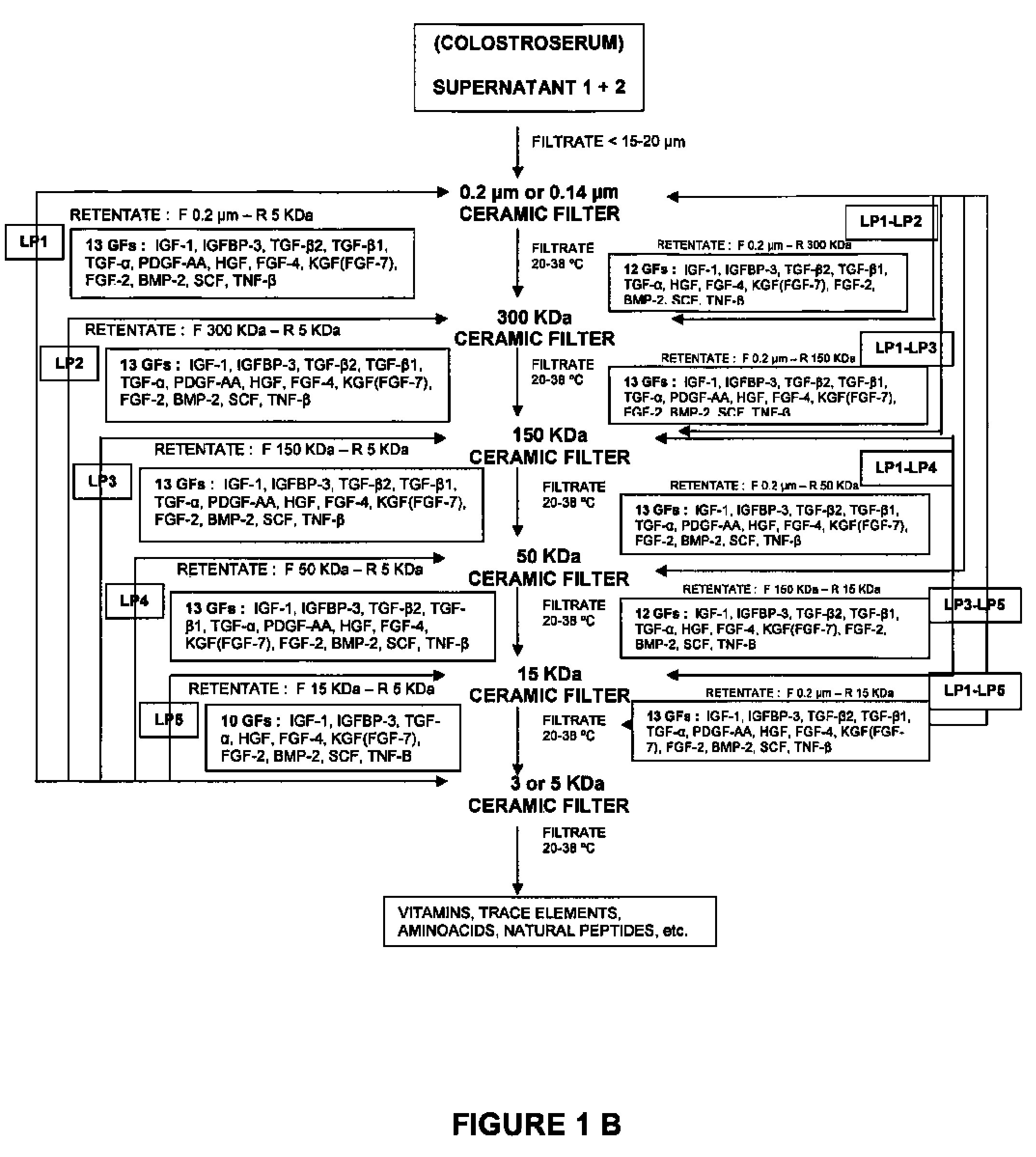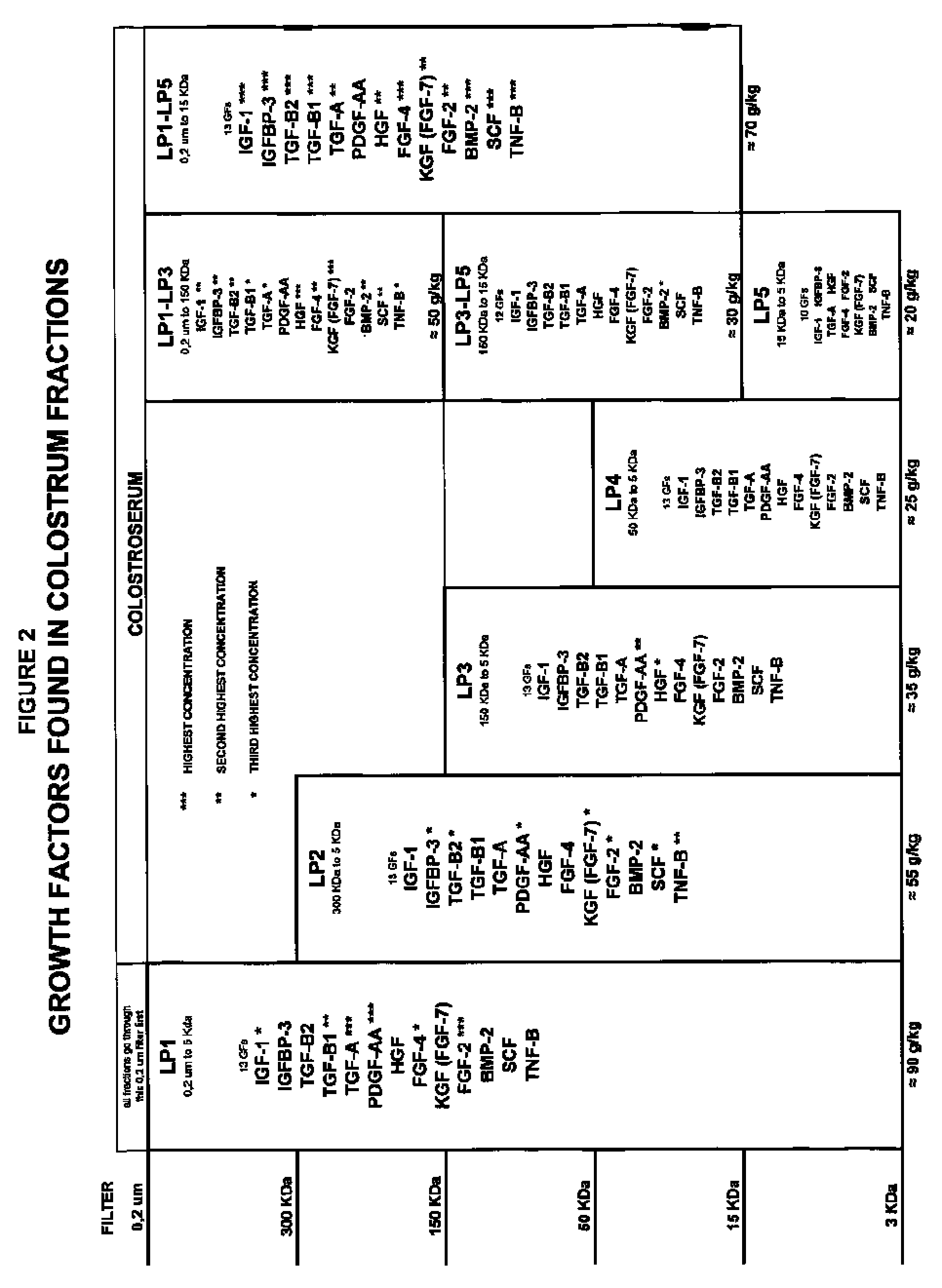Isolation of growth and differentiating factors from colostrum
a technology of growth factor and colostrum, which is applied in the field of isolating growth factor and differentiating factor from colostrum, can solve the problems of not being able to deliberately and simultaneously isolate growth factor with highly disparate molecular weights, and achieves the effects of minimizing cross-contamination, enhancing chondrocyte proliferation, and minimizing cross-contamination
- Summary
- Abstract
- Description
- Claims
- Application Information
AI Technical Summary
Benefits of technology
Problems solved by technology
Method used
Image
Examples
example 1
Isolation of Growth and Differentiating Factors from Commercially Available Bovine Colostrum
[0081]The process of the invention, shown schematically in FIGS. 1 (A) & (B), will now be described.
[0082]It should be appreciated here that while this process is specifically described for use with colostrum, substitutes for colostrum, namely other milks and milk products, may also be used. The efficiency of the process is believed to be enhanced with colostrum, because colostral milk contains a higher concentration of growth and differentiation factors than other milks and milk products. Colostral substitutes—filter sterilized milk, modified milk (i.e., milk from which the fatty constituents have been wholly or partially removed, with or without the addition of vitamins or solid elements derived from milk), enriched milk (i.e., enriched with non-fat solids), vitaminized milk (milk with vitamins added), and lacto-serum—may also be used as starting materials since they are known to contain gr...
example 2
Isolation of Growth and Differentiating Factors from Natural Colostrum (from Dairy Cows)
1. Preliminary Preparation
[0098]Frozen colostrum is thawed (storage temperature is −20° C.) then centrifuged 6 liters at a time at 20° C. The layer of butter and other residues are filtered first through cheesecloth and then through a Whatman™ 541 ashless filter. A thorough removal of this layer of fat will facilitate filtration and enhance the overall isolation of the growth and differentiating factors.
[0099]This preliminary filtration is followed by acid extraction at a pH of about 3.75-3.85. It is convenient to use a 10 N HCl solution for this purpose. If needed, water can be added to the supernatant (to a maximum of about 10%) in order to increase the fluidity of the supernatant for extraction. This greatly enhances filtration on the TAMILAB® system of columns (0.20 μm, 300 kDa, 150 kDa, 50 kDa, 15 kDa and 5 kDa), as will be described below.
[0100]The solution is now ready for filtration and l...
example 3
Preferred Isolation Method for LP1-LP5
[0102]The following process is based on that shown schematically in FIGS. 1(A) and (B).
1. Isolation
[0103]1.1 Starting with a lyophilized colostral preparation (freeze dried colostrum exempt of fat, coliforms, E. coli, S. aureus, salmonella, clostridium and antibiotics, colostrum is reconstituted by dissolving 1000 g of raw colostrum per 12 liters of water (0.2 μm filtered), placed in a blending tank (Hobart™) and agitated for 15 minutes;[0104]1.2 The pH is adjusted to between 3.75 and 3.85 with a 10 N HCl solution and run at ≈400 rpm for 60 minutes;[0105]1.3 The pH of the solution is readjusted with a 10N NaOH solution, to a pH of about 4.50-4.60, and the solution agitated for another 15 minutes at the same speed;[0106]1.4 The solution is centrifuged for 20 minutes at about 9285 G, 18° C. using a Beckman™ Avanti J-20XPX-12 with rotor JLA 8.1, centrifuging 6 liters at a time;[0107]1.5 The supernatant is filtered on Whatman 541 Ashless filter and ...
PUM
| Property | Measurement | Unit |
|---|---|---|
| temperature | aaaaa | aaaaa |
| sizes | aaaaa | aaaaa |
| molecular weights | aaaaa | aaaaa |
Abstract
Description
Claims
Application Information
 Login to View More
Login to View More - R&D
- Intellectual Property
- Life Sciences
- Materials
- Tech Scout
- Unparalleled Data Quality
- Higher Quality Content
- 60% Fewer Hallucinations
Browse by: Latest US Patents, China's latest patents, Technical Efficacy Thesaurus, Application Domain, Technology Topic, Popular Technical Reports.
© 2025 PatSnap. All rights reserved.Legal|Privacy policy|Modern Slavery Act Transparency Statement|Sitemap|About US| Contact US: help@patsnap.com



